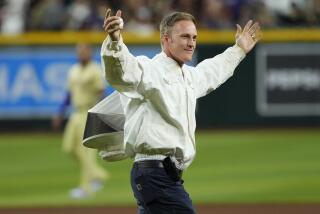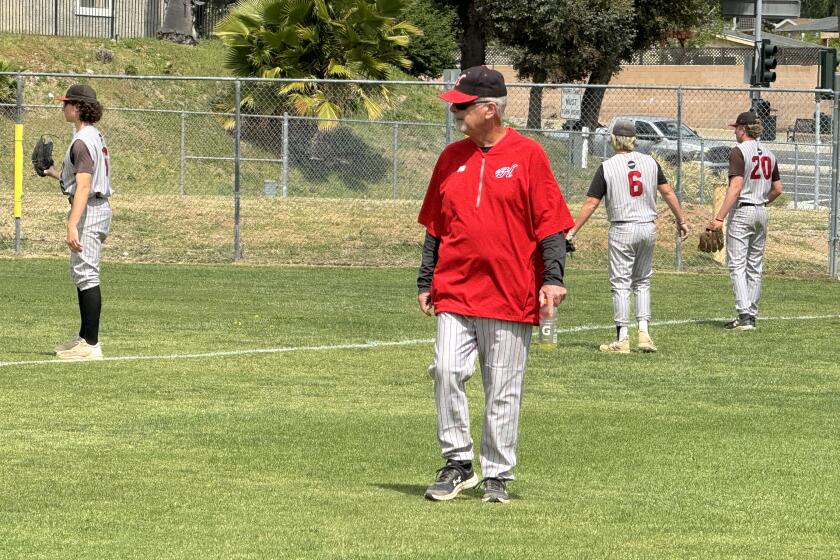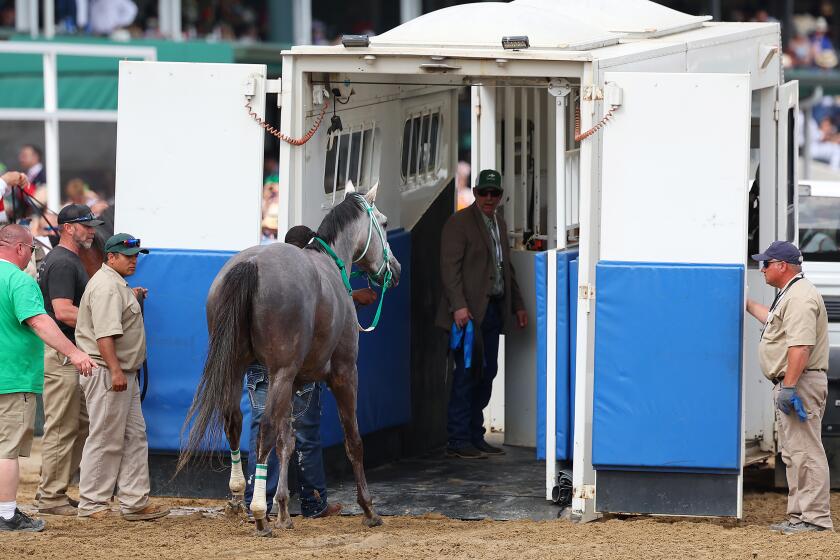Racers, Start Your Software, and May the Best Robot Win
The riderless motorcycle tore out of the chute and promptly plowed into a tin barricade.
Then, to the amazement of hundreds of spectators at Fontana’s California Speedway, the 90cc Yamaha named Ghostrider picked itself up and sped away.
For the record:
12:00 a.m. Oct. 7, 2005 For The Record
Los Angeles Times Friday October 07, 2005 Home Edition Main News Part A Page 2 National Desk 1 inches; 36 words Type of Material: Correction
Robotic vehicles -- An article in Wednesday’s Section A about a race of robotic vehicles said the TerraMax was built by Oshkosh Truck Corp. and Ohio State University. The vehicle was built entirely by Oshkosh Truck.
A year ago, 15 robot competitors participated in the Defense Department’s first million-dollar challenge to design a vehicle that could drive and navigate without a human controller.
It was a humiliating display, with only one robot managing to go seven miles before breaking down.
If this was the best the bots could do, the supremacy of mankind over wires and circuits was in no danger.
But as Ghostrider demonstrated at qualifying trials for this year’s race, the computers have gotten a lot smarter in 18 months.
“It was far better than my personal expectations,” said Anthony Tether, head of the Pentagon’s Defense Advanced Research Projects Agency, which is sponsoring the race.
The DARPA Grand Challenge is scheduled to take place Saturday, starting and finishing in Primm, Nev. Twenty contestants will try to complete the course of up to 175 miles to win a $2-million prize, twice as large as last year’s.
The robotic vehicles have 10 hours to complete the course, using only their own sensors and computer brains. The layout of the course is being kept secret until two hours before the race starts.
The goal of the challenge is to spur development of autonomous vehicles that can operate in dangerous environments, such as war zones.
“That’s what it’s all about: a whole bunch of those things on the Baghdad highway, resupplying our troops,” an announcer said as the largest entrant -- a 37,000-pound, six-wheel truck made by the Oshkosh Truck Co. and Ohio State University called TerraMax -- rumbled through the course.
In last year’s qualifying event, only seven teams completed the course.
This year, at least four times as many vehicles finished a tougher, two-mile qualifying course, squeezing through gates, maneuvering past obstructions and passing through a steel-lined tunnel that interfered with the vehicles’ global positioning systems.
“One of the vehicles was perfect -- it hit no obstacles, no gates,” Tether said after the first run last week, referring to Stanford University’s entry, Stanley.
A Volkswagen sport utility vehicle outfitted with cameras, laser guidance systems, an inertial system that functions like an inner ear to keep the vehicle oriented, and six computers, Stanley zipped through the course in less than 11 minutes, barely slowing for rental cars parked in its path.
“That is a world record,” Tether said.
The 43 competitors for the qualifying round, which ends today, came from 15 states. They included 17 universities, a high school and a few private companies, such as A.I. Motorvators from Los Angeles, whose entry, It Came From the Garage, really did.
With a beer keg stuck on the back and an on-off switch labeled “Brain,” it looks very much like an old hot rod and is about as low-tech as you get in this competition among buttoned-down engineers and Caltech grad students.
It has one computer brain. “We try not to have a whole bunch of sensors,” said former actor and long-haired race car driver Chris Pedersen, the team leader. “It adds complexity.”
Unlike its competitors, A.I. Motorvators has few corporate sponsors. Pedersen estimates that his team is $200,000 in debt.
On the other end of the spectrum is the Red Team of Carnegie Mellon University, considered the team to beat in the competition.
Their sponsors read like a Fortune 500 list: Boeing Co., Caterpillar Inc., Intel Corp., Snap-on Inc., Google Inc. and others. They have the resources to enter two vehicles, Highlander and Sandstorm, a modified Humvee that traveled the farthest of any last year.
“Carnegie Mellon is the team everybody loves to hate,” Jerry Fuller of UCLA’s team said. “They’re well-funded. They’re a little cocky. They have uniforms.”
Red Team’s compound hums like a well-oiled machine. Its air-conditioned trailer is outfitted with plush couches and all the soda you could drink.
Outside, on a covered patio, is a big flat-screen television. Dashing here and there are dozens of students in red hats and T-shirts, vaguely resembling Dr. No’s private army.
Dr. No himself, however, turns out to be a sweet, hulking robotics professor.
William “Red” Whittaker, 57, eschews the idea that the competition is a blood sport. Contestants are part of a fraternity “up to big things together,” said Whittaker, who raises cattle on a ranch outside Pittsburgh.
His vehicles have already run long distances during practice sessions in the desert, but there is no guarantee something unforeseen might not happen on race day. A week earlier, Highlander hit a rock, flipped and had to be substantially rebuilt.
Still, he said proudly, “On Highlander’s worst day, it’s good enough.”
There were several sentimental favorites, such as Ghostrider, which became a crowd pleaser for pluckily hopping back up when it fell over.
The UC Berkeley-Texas A&M; University Blue Team’s motorcycle barely got off the starting line last year. This time, they plan to do better.
“We could easily get 50 miles,” said engineering student Bryon Majusiak, 19.
Another favorite was CajunBot, a converted Max all-terrain vehicle that made a bleating noise like a lost infant searching for its mother as it careened around the course.
Just days before, team leader Scott Wilson of the University of Louisiana at Lafayette was in a boat rescuing people in New Orleans. “Our group got 500 people out over a five-day period,” he said.
Many team members have had to make room in their dorms for their parents, whose homes were destroyed by Hurricane Katrina. Wilson’s in-laws had been camping with him for five weeks.
Last year, CajunBot was first off the line. With the world’s media watching, the robot got less than an eighth of a mile from the start before running into a concrete barrier and landing in some bushes.
The team’s motto then was “Team CajunBot doesn’t quit.” This year, it’s “Stay dry.”
The fundamental problem for all the vehicles, said Tom Strat, DARPA’s program manager, is sorting through all the information streaming in and deciding how to react. There are two main types of information: navigation and sensing. The vehicles navigate by using their GPS to follow a set of programmed “waypoints” on the course.
The robot’s sensors -- lasers, cameras, conventional radar -- help the vehicle avoid obstacles such as rocks and cliffs.
The computer’s brain must figure out how to resolve any conflicts, such as when the path appears to steer the vehicle into a boulder.
During its first run, Team Golem’s Dodge truck ran off the course and up against a wall when its laser sensors detected phantom objects in its path.
The problem, Strat said, is that a computer still cannot understand its world. It merely senses it.
“Any 2-year-old can recognize its mother,” he said. “But we still don’t have the software” to do that.
Though every team has a strategy it thinks will help it best the competition, few competitors believe anyone will finish the course.
DARPA officials say they expect the best teams to get at least 75 miles into the course. The agency has already said that if no vehicle wins the prize, it will sponsor a third competition, with a prize doubled to $4 million.
Part of the problem with last year’s race was the public’s expectations, officials said.
“There is a huge disconnect between what people think robots can do and what they can really do,” said Tom Goodwin, a spokesman for the race. “We’re only a little farther along than the Wright brothers.”
Even so, competitors know they have to do better this time or risk more public humiliation.
“There’s nobody here that doesn’t know we have to deliver,” Goodwin said.
*
(BEGIN TEXT OF INFOBOX)
Robotic race
Sandstorm is a modified Humvee and one of 43 autonomous vehicles attempting to qualify for Saturday’s race of up to 175 miles through the desert starting and finishing in Primm, Nev.
GPS antennas track vehicle location
Springs and shocks help hold components steady
Long-range laser is stabilized and rotates in place
Short-range lasers determine if terrain is navigable
Shock Isolation box protects onboard computers in rough terrain
*
Seeing and avoiding obstacles
Radar bounces off obstacles such as a stalled vehicle or boulder
Computers plan alternative routes and pick the shortest and safest alternative
Source: Evan Tahler, Red Team
More to Read
Get our high school sports newsletter
Prep Rally is devoted to the SoCal high school sports experience, bringing you scores, stories and a behind-the-scenes look at what makes prep sports so popular.
You may occasionally receive promotional content from the Los Angeles Times.






